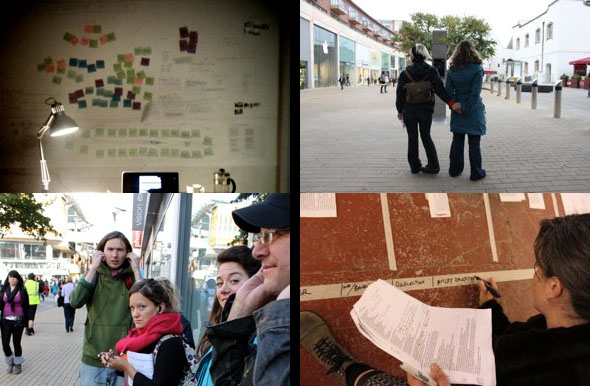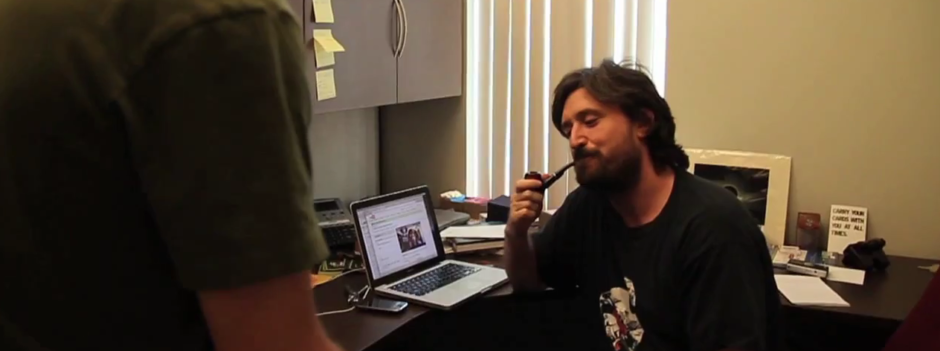[intro]Duncan Speakman’s Subtlemob project, “As if it were the last time,” will be taking place in Culver City this weekend as a part of the IndieCade Big Games program [sign up here]. The project immerses audiences in “the cinema of everyday life” by inviting them to quietly and anonymously gather at a secret location equipped with headphones, MP3 players, and customized sound files provided by the artist. By all accounts, the ensuing experience is a powerful one, something that “captures what it is to escape from the world for a little bit – and then to return and find that you see things just a bit differently.” In the interview below, Duncan talks about his trajectory as a media artist and the curious connections between locative art and the core impulses of documentary cinema.[/intro]

Your work brings together locative media, social media, performance, interaction design, sound design, and something akin to real-time filmmaking (without a camera). How did you end up working in this heavily mixed space? That is, what’s your background as an artist, and what led from there to here?
I began as a musician, and an interest in technology led me to becoming a sound engineer. While I was studying sound enginnering at university I got turned on to to documentary production and post-production. At this point I moved to Bristol (partly led by the music scene that was around at the time, Portishead, Tricky et al). I soon got a computer and started teaching myself interactive software and became involved in developing prototypes for interactive television documentaries within the broadcast industry. It quickly became apparent that the ideas I had didn’t work on a 4:3 television screen and I found myself drifting into the art scene, where I could explore my ideas for interactive documentaries in an installation context. Over time my main work shifted into public spaces, while my sketchpad was a series of online videos that I considered to be micro-documentaries. Single take shots of everyday moments which I would present in slow motion and write a soundtrack for. Sometime after this I began working with GPS technology and located sound, there was a bit of an epiphany moment where I suddenly found myself walking around listening to my sound pieces, and seeing the films I had been making happening around me, te real world framed by the soundtrack. Previously I had shunned walkmans because of the way ey cut you off from your acoustic space, but I suddenly saw them as an opportunity to make people connect with the world around them by framing it in the same way I would create documentaries.
What are the big touchstones (artists, projects, movements, etc) for you?
From a visual perspective I think one of my biggest influences is Roy Anderson (‘you the living’, ‘songs from the second floor’). His films are detailed and heavily constructed fictions, but essentially appear to me as a series of individual framed moments of the everyday that come together to create a reflective picture of society, plus they’re funny. I haven’t managed to get the funny bit in my work yet, but I’m trying! Soundwise I find myself drawing inspiration from music that works well when listened to in public spaces, I guess this seems an obvious choice! What I mean is that there’s a huge variety of music in the world that blows me away, but some of it works better at a concert or on a home stereo. For walking the streets (and framing the world) I love Taylor Deupree, Fennesz, Godspeed You Black Emporer, Tool, and a bit of Maria Callas. Recently though my ears have been pricked by Ben Frost, his stuff has absolutely knocked me sideways so now I’m worried my next piece is going to end up ripping him off too much!
For text I find my influences in many places, aesthetically I love Ben Marcus at the moment and I’m beginning to understand Sylvia Plath, but in terms of what I’m actually making I think I’ve accidentasly become the protagonist in Tom McCarthy’s ‘Remainder’, a man who spends all his effort on getting people to renact the everyday world just so he can have a richer experience (sorry Tom, that is an incredibly dumbed down description of one of my favourite ever books!)
On your website, you speak of employing walking as “both a process and/or an outcome of my work.” What is it about walking and being in public space that’s so charged with meaning?
I guess it’s where I now locate the ‘interaction’ in my work. Although I’ve returned recently to using pre-recorded linear soundtracks (as opposed to GPS or other responsive systems) the audiences still have to interact with the world when they move through it. Forcing them to move through public space forces them to deal with an environment I can’t control, forget gestural interfaces, this is real interaction, ha! But there’s also something about the narrative of a walk that I enjoy, and I like relating it to musical dynamics. The relationship goes both ways, the speed of your movment is often influenced by the pace of the soundtrack you’re listening to, but also your sense of the music is changed depending on whether your moving through a crowd in a narrow street, or walking out on to an empty plaza. When I’m writing the music with Sarah Anderson our process is to sketch out a few ideas and then take them out and walk them. We note what they make us aware of, and how they influence our movement, then we adapt and rewrite and re-walk until they are creating the effect we’re looking for. Sometimes I think that the main reason I brought walking (which I enjoy for pleasure anyway) into my work was to ensure I didn’t spend so much time spent in a dark studio, and that now I HAVE to get outside to write the music.

Because I’m a fan of the NFB, I’m also a fan of John Grierson. I was pleasantly surprised to see a reference to him on your site. How is it that you see your work as a kind of documentary?
Grierson described documentary as ‘the creative treatment of actuality’, films like ‘nightmail’ and ‘coal face’ seem so far removed from the type of ‘documentary’ that fills our screens today. They took everyday realities and framed then within beautiful soundtracks, creative musical editing techniques, poetry and abstraction. I guess that’s the kind of documentary I’m trying to make, ones that show us nothing more than the everyday, but try and show us how beautiful it can be. When audiences in my work are performing instructions, those instructions have been derived from observed events, so really they are just the sort of ‘re-enactments’ that traditional documentaries use all the time. I suppose that even at a base level I’m just asking people to watch the world around them, I’m just giving them a soundtrack, a natural history voiceover for anthropological documentaries about urban life? That’s probably talking it up a bit too much!!
What are your thoughts about running a walking-oriented game in a car-oriented city like Los Angeles? Can you imagine a pervasive project that could work with the car culture instead of against it?
Oh, that’s a very tough question! I can imagine something that uses cars, maybe uses their windows as frames for the world in a cinematic style, but I don’t think I’d let the audience do the driving, imagine if they were so distracted by the experience they drove into a pedestrian who was taking part in one of my other works! that would ruin everything!
UPDATE: Photos from ‘as if it were the last time’ at IndieCade here.
